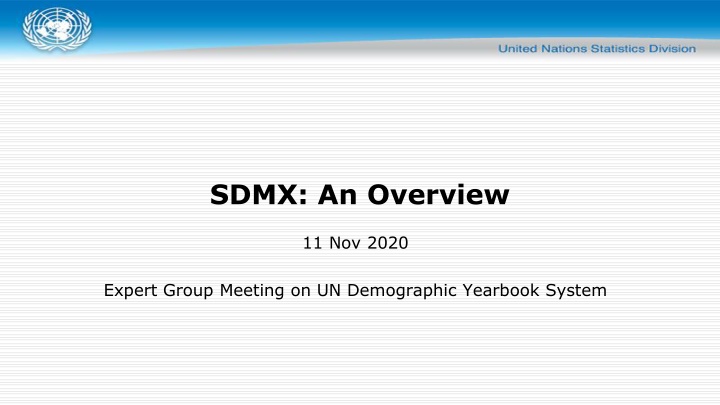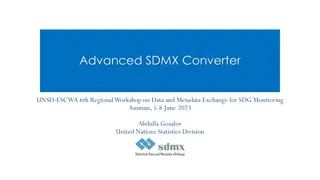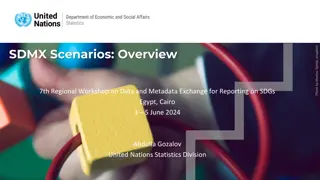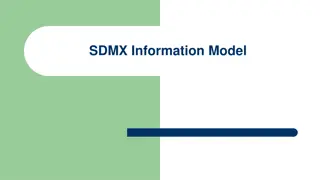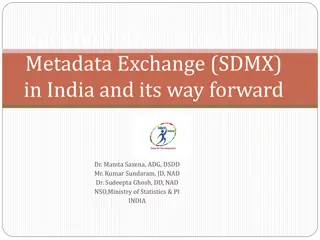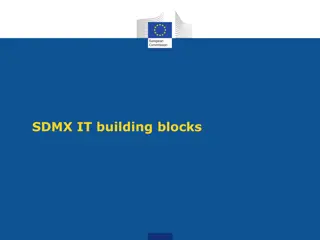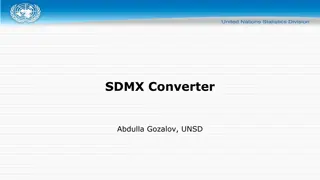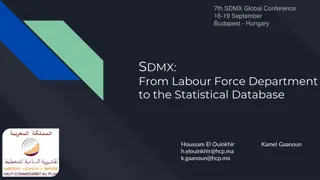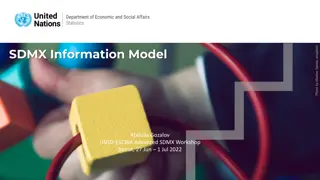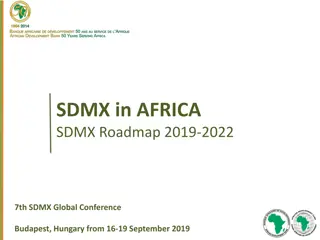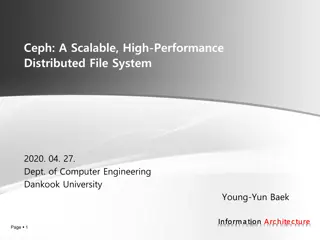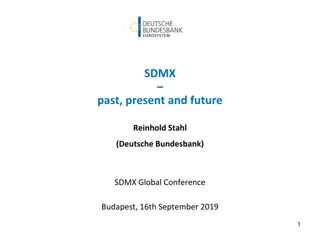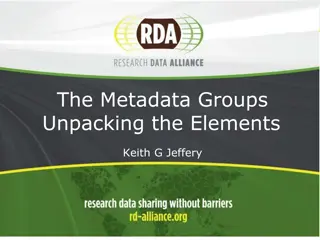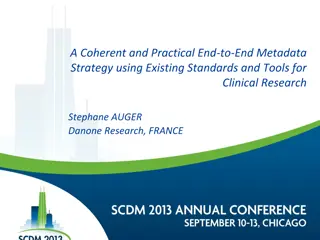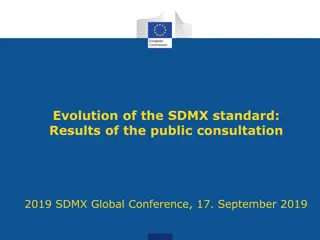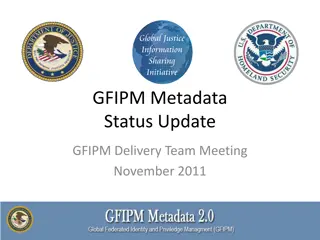SDMX: Statistical Data and Metadata eXchange Overview
Statistical Data and Metadata eXchange (SDMX) is an initiative sponsored by seven international organizations to standardize data exchange. Originally designed for international organizations and countries, SDMX's utility has expanded to include processing, validation, and dissemination of data. It serves as the infrastructure standards for structuring, packaging, and registry of statistical data and metadata, offering technical specifications and guidelines for implementation. Various SDMX-related tools are available to support different scenarios, from basic infrastructure to advanced information systems.
Download Presentation

Please find below an Image/Link to download the presentation.
The content on the website is provided AS IS for your information and personal use only. It may not be sold, licensed, or shared on other websites without obtaining consent from the author.If you encounter any issues during the download, it is possible that the publisher has removed the file from their server.
You are allowed to download the files provided on this website for personal or commercial use, subject to the condition that they are used lawfully. All files are the property of their respective owners.
The content on the website is provided AS IS for your information and personal use only. It may not be sold, licensed, or shared on other websites without obtaining consent from the author.
E N D
Presentation Transcript
SDMX: An Overview 11 Nov 2020 Expert Group Meeting on UN Demographic Yearbook System
What is SDMX? Statistical Data and Metadata eXchange An initiative sponsored by seven international organizations Bank for International Settlements European Central Bank Eurostat International Monetary Fund Organization for Economic Cooperation and Development United Nations World Bank Approved by the United Nations Statistical Commission as the preferred standard for statistical data and metadata exchange. A registered ISO standard. 2
Objectives of SDMX SDMX was originally designed to standardize data and metadata exchange between and among international organizations and member countries. However, the power and utility of its underlying information model has increasingly broadened the scope of use of SDMX in addition to data/metadata exchange Processing Validation Dissemination 3
SDMX as the Infrastructure Standards for: Structuring of statistical data Packaging of statistical data as XML, JSON, CSV, and other formats Registry of data and metadata Application Programming Interface (API) Specifications, guidelines, tools, and manuals are freely provided to support implementation 4
SDMX Specifications and Guidelines Technical specifications Speak the same IT language Describe the container (i.e. the message) SDMX Guidelines Speak the same statistical language Describe the content (i.e. data and metadata) Source: Eurostat 5
SDMX Tools Overview A large number of SDMX-related tools that implement the technical specifications have been developed by different organizations. Some but far from all include: Structure maintenance DSD Constructor (ILO), Matrix Generator (OECD), Fusion Registry Community Edition (Metadata Technology) Data mapping and preparation SDMX Converter (Eurostat), SMART (ILO), SDMX Reference Infrastructure (Eurostat) , Fusion Registry Enterprise Edition (Metadata Technology, subscription based) Data, metadata, and structure dissemination .Stat (OECD), SDMX Reference Infrastructure (Eurostat), Fusion Registry Enterprise Edition (Metadata Technology, subscription based) The tools can support various scenarios: from very limited infrastructure to fully developed information systems to SDMX-native data warehouse 6
Development of the technical Standard 2004: SDMX 1.0 2005: SDMX 2.0 2011: SDMX 2.1 2021: SDMX 3.0 Improved usability Enriched message formats and API Overhauled, improved support for reference metadata Support for geospatial information Extensibility of code lists Numerous other improvements 7
Statistical Data Structures SDMX specifies how statistical data can be structured. Technical specification does not detail specific structures or codes, it only provides a framework for developing those. Guidelines, best practices, and recommended building blocks including structures and codes are provided at the sdmx.org web site. Data Structure Definitions (DSDs) describe characteristics of the data to be exchanged. A DSD must be developed before any SDMX exchange, dissemination, or processing can take place. 8
Where do those DSDs come from? Generally, when SDMX is used for reporting, a global DSD will have been developed by an international working group, such as those for Macro-Economic Statistics, Labor, SDGs Take the global DSD, use tools to map your data to the DSD, convert to SDMX, and provide to the recipient. Global DSDs are published at the SDMX Global Registry. When SDMX is used for dissemination, you create your own DSD and publish the data at your web site Dissemination DSDs may use internal concepts and codes but it is desirable to use global concepts and codes, when available, for better interoperability. Global DSDs may also be used for dissemination, and customized dissemination platforms are increasingly developed for those. 9
Guidelines: SDMX Glossary Common terminology to be used in order to facilitate communication and understanding Concepts and related definitions used in structural and reference metadata of international organisations and national data- producing agencies Overall message: if a term is used, then its precise meaning should correspond to the Glossary definition, and any reference to a particular phenomenon described in the Glossary should use the appropriate term 250 concepts stored in a Concept Scheme in the Global Registry 10
Guidelines: Cross-Domain Code Lists Used to support cross-domain concepts Higher efficiency (through re-use), easier maintenance, less mappings Stored as SDMX Codelists in the Global Registry Some 20 cross-domain CLs currently available at the Global Registry (more under development), including Reference Area Sex Degree of Urbanisation Civil Status Occupation 11
Development of Global Structures Initially, focus on economic and trade statistics National Accounts, Balance of Payments, Foreign Direct Investment Consumer Price Index International Merchandise Trade More recently, increasing focus on environmental and social statistics Sustainable Development Goals Labour SEEA 12
SDMX Global Registry http://registry.sdmx.org Repository of cross-domain concepts, code lists, global structures Facilitates and simplifies reuse of global structures Can be used from within various tools 13
What about Reference Metadata? Reference metadata exchange has lagged far behind data exchange in terms of implementation rates Complexity Scarcity of tools available Usability issues Advanced pilot SDG metadata exchange underway Extracting rich text from MS Word templates and converting to SDMX SDMX metadata available at an API Overhauled support in SDMX 3.0 Greatly simplified and improved Expected to lead to increased availability of tools and wider implementation rates 14
THANK YOU! 15
